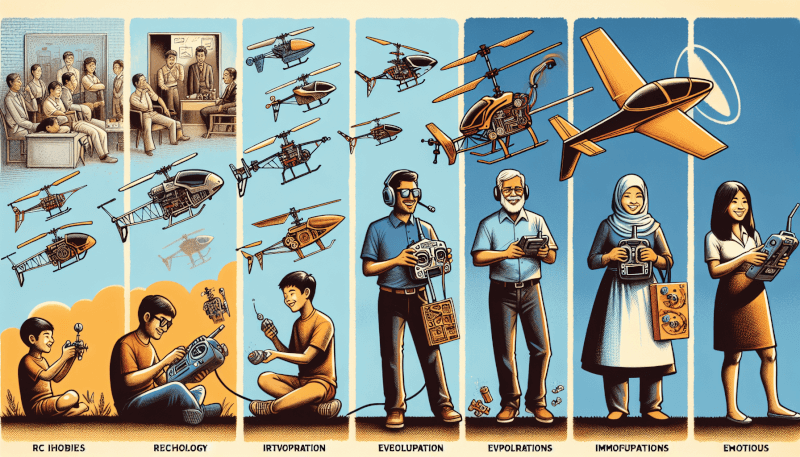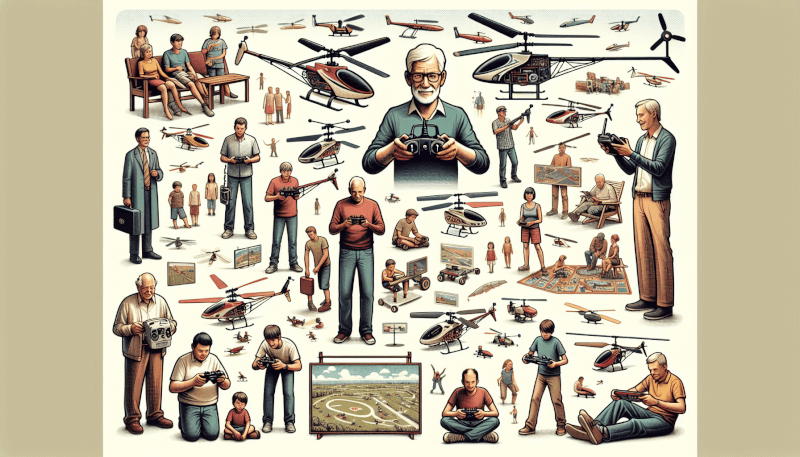Imagine yourself transported back in time to the early 1960s, a time when remote-controlled helicopters were nothing more than a distant dream for avid hobbyists. Fast forward to the present day, and you’ll find a thriving community of enthusiasts, dedicated to perfecting their piloting skills and showcasing the capabilities of these miniature aircraft. This captivating article explores the fascinating journey of remote-controlled helicopters, from their humble beginnings as a niche hobby to their current status as a beloved pastime for enthusiasts all around the world. Get ready to be swept up in the story of how these small machines have captured the hearts of so many, turning ordinary individuals into avid RC heli lovers.

The Early Days of RC Heli
Invention of the first RC helicopter
The beginnings of RC helicopter technology can be traced back to the early 20th century. It was in the late 1930s that the first remote-controlled helicopter prototype was developed by a French engineer named Etienne Oehmichen. This early model featured a series of mechanical linkages and controls for achieving basic flight maneuvers. While it may not have been as sophisticated as modern RC helicopters, this invention laid the foundation for future advancements in the field.
Early commercial availability of RC helicopters
It wasn’t until the 1960s that the first commercially available RC helicopters hit the market. Companies like Hirobo and Kavan began producing and selling these models, though they were still relatively limited in terms of capabilities and flight performance. The radios used to control these helicopters were often unreliable and had limited range, making it a challenge for pilots to achieve precise control over their aircraft.
Limited popularity among hobbyists
In the early days, RC helicopters were seen as niche products and were not as widely popular as other radio-controlled aircraft like planes or cars. This was partly due to the complexity and skill required to fly them. RC helicopters demanded a higher level of piloting skills and were often intimidating for beginners. Additionally, the cost of ownership, both in terms of initial purchase and maintenance, deterred many potential hobbyists. However, for those who were fascinated by the challenge and excitement of helicopter flight, the allure of RC heli proved irresistible.
Advancements in RC Heli Technology
Introduction of collective pitch control
One of the most significant advancements in RC heli technology was the introduction of collective pitch control in the 1980s. Prior to this, RC helicopters used fixed-pitch rotor blades, which restricted maneuverability and limited flight capabilities. Collective pitch control allowed pilots to vary the pitch angle of the rotor blades collectively, enabling precise control of lift and maneuverability. This breakthrough greatly enhanced the performance and flight characteristics of RC helicopters, setting the stage for more advanced maneuvers and aerobatics.
Improvements in flight stability
In the early days, RC helicopters were notorious for their unstable flight characteristics, often requiring constant adjustments to maintain control. However, as technology progressed, so did the stability of these aircraft. Advances in gyroscopes and flight control systems significantly improved stability by automatically countering unwanted movements and keeping the helicopter level. This stability enhancement made RC helicopters more accessible to hobbyists, as they no longer needed to possess expert piloting skills to enjoy the hobby.
Miniaturization and increased power
The miniaturization of electronic components and advancements in battery technology led to smaller and more powerful RC helicopters. This allowed for greater maneuverability and more agile flight. With smaller and lighter builds, RC helicopters could perform intricate aerobatics and 3D maneuvers with ease, captivating the imaginations of pilots and spectators alike. These advancements also made it easier for hobbyists to transport and fly their helicopters in various locations.
Use of brushless motors and LiPo batteries
The transition from brushed motors to brushless motors revolutionized RC helicopter performance. Brushless motors offered higher efficiency, reduced maintenance, and increased power output. Paired with Lithium Polymer (LiPo) batteries, which provided higher energy density and longer flight times, RC helicopters became more powerful and capable than ever before. These advancements enabled pilots to push the boundaries of flight, performing complex aerobatics and stunts with precision and control.
Integration of gyroscopic stabilization
To further enhance stability and control, gyroscopic stabilization systems were integrated into RC helicopters. These systems utilized gyroscopes to detect and counteract unwanted movements caused by wind, turbulence, or abrupt control inputs. With gyroscopic stabilization, the helicopters could remain stable and level, even in challenging flight conditions. This technology greatly aided beginner pilots in their learning process, allowing them to focus on developing their piloting skills without constantly battling the forces of nature.
Enhanced maneuverability and 3D capabilities
With the advancements in RC heli technology, the world of aerobatics and 3D flying opened up to enthusiasts. RC helicopters could now perform a wide range of maneuvers such as loops, rolls, flips, and inverted flight. Pilots could push the boundaries of what was previously thought possible, showcasing their skills in thrilling aerial displays. The ability to execute precise and complex 3D maneuvers became a defining characteristic of the RC heli hobby, enticing more pilots to test their abilities and unlock new levels of excitement.

RC Heli as a Hobby
Rise of RC heli clubs
As the popularity of RC helicopters grew, so did the formation of RC heli clubs. These clubs provided a platform for enthusiasts to come together, exchange knowledge, and share their love for the hobby. Joining a club offered pilots the opportunity to learn from experienced members, access specialized training facilities, and engage in group flying sessions. RC heli clubs fostered a sense of community and camaraderie among individuals who share a passion for these flying machines.
Competitions and events
The emergence of RC heli competitions and events further solidified the hobby’s presence and allowed pilots to showcase their skills in friendly competition. Fly-in events, aerial displays, and skill-based competitions became popular, attracting pilots from various locations. These gatherings became a hub for enthusiasts to exchange tips, witness impressive aerial performances, and observe the latest advancements in RC heli technology.
Development of specialized gear and accessories
As the interest in RC helicopters grew, so did the market for specialized gear and accessories. Manufacturers began catering to the specific needs of RC heli pilots, producing high-quality components like rotor blades, servos, and flight controllers. Accessories such as aftermarket canopies, scale fuselages, and LED lighting kits allowed pilots to personalize their helicopters and add their unique touch to their flying machines. The availability of these specialized products not only enhanced the performance of RC helicopters but also added an element of customization and individuality to the hobby.
Importance of flight simulators for practice
Flight simulators played a crucial role in the advancement and accessibility of RC heli flying. These software applications provided pilots with a realistic virtual environment to practice and hone their skills. Simulators allowed pilots to test and experiment with different maneuvers, without the risks associated with crashing or damaging their physical helicopters. They became an invaluable tool for both beginners and experienced pilots, aiding in the development of muscle memory, hand-eye coordination, and overall piloting proficiency.
RC Heli in the Military and Professional Sector
Applications in military reconnaissance
The military sector recognized the potential of RC helicopters early on, particularly for reconnaissance purposes. RC helicopters equipped with cameras or sensors allowed military personnel to acquire real-time information in areas that were otherwise difficult or dangerous to access. These unmanned aerial vehicles provided valuable data for decision-making, surveillance, and tactical operations.
Remote-controlled drones and unmanned aerial vehicles
With the exponential growth of RC heli technology, the concept of remote-controlled drones and unmanned aerial vehicles (UAVs) evolved. These versatile machines found applications in various sectors, such as aerial photography, search and rescue operations, agricultural surveys, and more. The advancements made in RC heli technology played a significant role in shaping the landscape of modern drone design and capabilities.
Utilization in professional aerial photography and filming
The stability, maneuverability, and improved camera-carrying capacity of RC helicopters have made them invaluable tools in the field of professional aerial photography and filmmaking. With the ability to capture breathtaking aerial shots from unique perspectives, RC helicopters have revolutionized the art of cinematography. Their nimble nature allows for precise positioning and smooth camera movements, adding depth and immersion to visual storytelling.

Popularity Surge and the Rise of Enthusiasts
Increased affordability and accessibility
As technology progressed, the cost of RC heli ownership decreased significantly, making it more accessible to a wider range of hobbyists. Key advancements like mass production, improved manufacturing techniques, and economies of scale all contributed to the affordability of RC helicopters. This increased affordability, coupled with the availability of entry-level models and comprehensive starter kits, led to a surge in popularity and a growing community of RC heli enthusiasts.
Online communities and forums
The rise of the internet brought together RC heli enthusiasts from all over the world, allowing them to connect, share knowledge, and discuss their passion online. Online communities and forums became a hub for enthusiasts to seek advice, troubleshoot issues, and share their experiences. These virtual spaces fostered a sense of belonging and facilitated the exchange of ideas, helping pilots stay up-to-date with the latest developments in RC heli technology.
Sharing of tips, tricks, and modifications
Within the RC heli community, a culture of sharing thrived. Enthusiasts were eager to share their tips, tricks, and modifications to improve the performance of their helicopters. From aerodynamics tweaks to unique customization ideas, enthusiasts freely shared their knowledge to help others unlock the full potential of their RC helicopters. This collaborative spirit not only enhanced the overall experience but also cultivated a sense of camaraderie among hobbyists.
Building and customization culture
Building and customizing RC helicopters became another facet of the hobby that appealed to enthusiasts. Some pilots found joy in assembling kits and fine-tuning their helicopters to their exact specifications. Customization options such as choosing different rotor blades, tail booms, and canopies allowed pilots to create a unique and personalized RC heli. This building and customization culture added depth and satisfaction to the hobby, as pilots took pride in their handcrafted flying machines.
Safety Concerns and Regulations
Risk of accidents and injuries
While RC helicopters provide countless hours of entertainment and enjoyment, it is important to acknowledge the risks associated with flying them. Accidents can occur, potentially resulting in damage to property or, in rare cases, injury to individuals. It is crucial for pilots to adhere to safety guidelines and exercise caution when operating their helicopters. Understanding the proper use of equipment, maintaining distance from people and objects, and practicing responsible flying habits are all essential for keeping both pilots and bystanders safe.
Flight restrictions in certain areas
Flying RC helicopters can be subject to flight restrictions in certain areas to ensure public safety. It is important for pilots to be aware of local regulations, which may include no-fly zones, altitude limitations, and designated flying areas. Pilots should always research and follow the guidelines set by governmental and regulatory bodies to maintain the reputation of the RC heli community and prevent incidents that could lead to restrictions on the hobby.
Airspace regulations for larger RC helicopters
For larger RC helicopters that are capable of reaching higher altitudes, airspace regulations become more relevant. Pilots must familiarize themselves with local airspace regulations, which might require obtaining special permissions or adhering to specific flight paths. Compliance with these regulations is essential to ensure the safety of both air traffic and the general public.

Technology Cross-Overs
Integration of RC heli technology in other industries
The advancements made in RC heli technology have found uses beyond the hobbyist community. Many industries have integrated RC heli technology into their operations, benefiting from the agility, stability, and precision these machines offer. Sectors such as aerial surveying, infrastructure inspection, agricultural monitoring, and disaster management have embraced the capabilities of RC helicopters to improve efficiency and gather valuable data.
Use of RC helis in educational settings
Educational institutions have also recognized the educational value of RC helicopters. By introducing students to RC heli technology, these institutions foster an interest in science, technology, engineering, and mathematics (STEM) fields. RC helis serve as a hands-on learning tool, teaching students about aerodynamics, electronics, mechanics, and problem-solving. This practical application of knowledge offers an engaging and interactive approach to learning, stimulating the curiosity and creativity of young minds.
Influence on drone and quadcopter design
The technological advancements made in RC heli technology have had a profound impact on the design and development of drones and quadcopters. Many of the features present in modern drones, such as gyroscopic stabilization, brushless motors, and flight controllers, trace their origins back to RC helicopter technology. The expertise gained through the RC heli hobby has directly contributed to the evolution of UAVs, enabling the development of more efficient, stable, and intelligent aerial platforms.
Innovations and Future Developments
Advancements in autonomous flight systems
The future of RC helis and drones lies in the development of autonomous flight systems. With advancements in artificial intelligence and computer vision, it is becoming increasingly possible to automate various aspects of flight, including takeoff, landing, and obstacle avoidance. These autonomous capabilities will open up new possibilities for applications in industries such as delivery services, aerial inspections, and even passenger transportation.
Emerging technologies for improved control and stability
Researchers and engineers are continually developing new technologies to enhance the control and stability of RC helicopters. From advanced flight control algorithms to novel sensor systems, these innovations aim to make flying RC helis even more intuitive and precise. The integration of machine learning and sensor fusion techniques holds promise for further improving flight characteristics and providing a more seamless piloting experience.
Miniaturization and increased power efficiency
Miniaturization of components has always been a driving force in the RC heli hobby. As technology continues to advance, components are becoming smaller, more lightweight, and more power-efficient than ever before. This trend allows for even smaller and nimbler RC helicopters, as well as improved flight times and battery performance. The continued miniaturization and increased power efficiency will bring about new possibilities and facilitate the development of even more compact and capable RC helicopters.
Integration of artificial intelligence
Artificial intelligence opens up a realm of possibilities for the future of RC helis. Imagine intelligent flight systems that can analyze flight data in real-time, learn from pilot inputs, and make intelligent decisions to optimize performance and safety. These AI-driven advancements could take the hobby to new heights, making RC helicopter flying even more intuitive, efficient, and enjoyable.

Collecting and Restoring RC Helicopters
Value and rarity of vintage RC helicopter models
Just like any other collectible, vintage RC helicopter models hold value and are highly sought after by collectors. As time passes, certain models become rarer and harder to find, making them prized possessions for enthusiasts. The nostalgia associated with vintage RC helicopters, coupled with their historical significance, adds to their allure and collectability. The market for vintage RC helicopters continues to thrive, with collectors eagerly searching for and restoring these iconic pieces of RC heli history.
Restoration techniques and challenges
Restoring vintage RC helicopters requires a combination of technical skills, knowledge, and patience. Bringing a neglected or damaged helicopter back to its former glory can be a rewarding and satisfying endeavor. Some of the challenges involved in restoration include sourcing original parts, repairing or replacing worn-out components, and ensuring the authenticity and historical accuracy of the restoration process. Despite the challenges, the satisfaction of seeing a beautifully restored RC helicopter is worth the effort for many collectors.
Thriving collector’s market
The collector’s market for RC helicopters continues to thrive, with enthusiasts actively buying, selling, and trading these unique items. Collectors take pride in showcasing their carefully curated collections, which often include rare and hard-to-find models. The collector’s market also provides a platform for enthusiasts to connect, exchange knowledge, and preserve the history and heritage of RC heli technology.
Conclusion
The journey of RC helicopters, from their humble beginnings to their current status as a beloved hobby, has been one of constant innovation and excitement. Advancements in technology, increased accessibility, and the passion of the RC heli community have propelled the hobby to new heights. From the early days of mechanical linkages to the integration of artificial intelligence, RC helicopters have evolved into sophisticated machines capable of breathtaking aerial maneuvers. The hobby’s influence has extended beyond enthusiasts, leaving a lasting impact on industries such as photography, filmmaking, and even education. With continued advancements and future developments on the horizon, the sky is truly the limit for RC helis and their dedicated community of hobbyists and enthusiasts.


